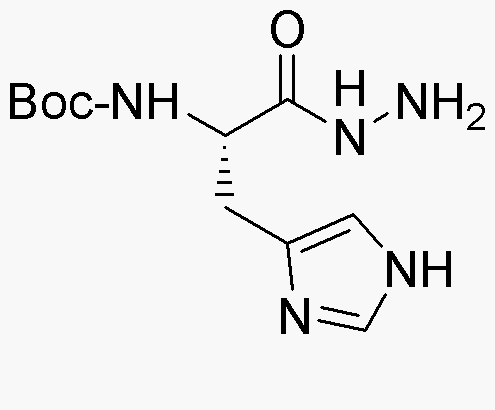Na-Boc-L-histidine hydrazide is widely utilized in research focused on:
- Peptide Synthesis: This compound serves as a valuable building block in the synthesis of peptides, particularly those containing histidine residues, which are crucial for various biological functions.
- Drug Development: It plays a role in the development of pharmaceuticals, especially in creating compounds that target specific biological pathways, enhancing the efficacy and selectivity of drug candidates.
- Bioconjugation: The hydrazide functional group allows for efficient bioconjugation techniques, enabling the attachment of drugs or imaging agents to biomolecules, which is essential in targeted therapy and diagnostics.
- Research in Enzyme Inhibition: Researchers utilize this compound to study enzyme inhibition mechanisms, particularly in the context of histidine-containing enzymes, providing insights into metabolic pathways.
- Protein Modification: It is used in the modification of proteins to study structure-function relationships, aiding in the understanding of protein interactions and stability.
Informations générales
Propriétés
Sécurité et réglementation
Applications
Na-Boc-L-histidine hydrazide is widely utilized in research focused on:
- Peptide Synthesis: This compound serves as a valuable building block in the synthesis of peptides, particularly those containing histidine residues, which are crucial for various biological functions.
- Drug Development: It plays a role in the development of pharmaceuticals, especially in creating compounds that target specific biological pathways, enhancing the efficacy and selectivity of drug candidates.
- Bioconjugation: The hydrazide functional group allows for efficient bioconjugation techniques, enabling the attachment of drugs or imaging agents to biomolecules, which is essential in targeted therapy and diagnostics.
- Research in Enzyme Inhibition: Researchers utilize this compound to study enzyme inhibition mechanisms, particularly in the context of histidine-containing enzymes, providing insights into metabolic pathways.
- Protein Modification: It is used in the modification of proteins to study structure-function relationships, aiding in the understanding of protein interactions and stability.
Documents
Fiches de données de sécurité (FDS)
La FDS fournit des informations de sécurité complètes sur la manipulation, le stockage et l’élimination du produit.
Spécifications du produit (PS)
Le PS fournit une description complète des propriétés du produit, notamment sa composition chimique, son état physique, sa pureté et les exigences de stockage. Il détaille également les plages de qualité acceptables et les applications prévues du produit.
Certificats d'analyse (COA)
Recherchez des certificats d'analyse (COA) en saisissant le numéro de lot du produit. Les numéros de lot et de lot se trouvent sur l'étiquette d'un produit, après les mots « Lot » ou « Lot de fabrication ».
Numéro de catalogue
Numéro de lot/série
Certificats d'origine (COO)
Ce certificat d'exploitation confirme le pays dans lequel le produit a été fabriqué, et détaille également les matériaux et composants utilisés et s'il est issu de sources naturelles, synthétiques ou autres sources spécifiques. Ce certificat peut être requis pour les douanes, le commerce et la conformité réglementaire.
Numéro de catalogue
Numéro de lot/série
Fiches de données de sécurité (FDS)
La FDS fournit des informations de sécurité complètes sur la manipulation, le stockage et l’élimination du produit.
DownloadSpécifications du produit (PS)
Le PS fournit une description complète des propriétés du produit, notamment sa composition chimique, son état physique, sa pureté et les exigences de stockage. Il détaille également les plages de qualité acceptables et les applications prévues du produit.
DownloadCertificats d'analyse (COA)
Recherchez des certificats d'analyse (COA) en saisissant le numéro de lot du produit. Les numéros de lot et de lot se trouvent sur l'étiquette d'un produit, après les mots « Lot » ou « Lot de fabrication ».
Numéro de catalogue
Numéro de lot/série
Certificats d'origine (COO)
Ce certificat d'exploitation confirme le pays dans lequel le produit a été fabriqué, et détaille également les matériaux et composants utilisés et s'il est issu de sources naturelles, synthétiques ou autres sources spécifiques. Ce certificat peut être requis pour les douanes, le commerce et la conformité réglementaire.


